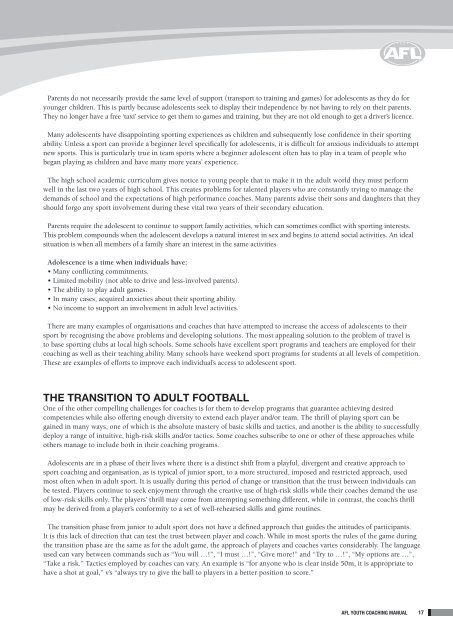2012 Youth Coaching Manual - AFL Community
2012 Youth Coaching Manual - AFL Community
2012 Youth Coaching Manual - AFL Community
You also want an ePaper? Increase the reach of your titles
YUMPU automatically turns print PDFs into web optimized ePapers that Google loves.
Parents do not necessarily provide the same level of support (transport to training and games) for adolescents as they do for<br />
younger children. This is partly because adolescents seek to display their independence by not having to rely on their parents.<br />
They no longer have a free ‘taxi’ service to get them to games and training, but they are not old enough to get a driver’s licence.<br />
Many adolescents have disappointing sporting experiences as children and subsequently lose confidence in their sporting<br />
ability. Unless a sport can provide a beginner level specifically for adolescents, it is difficult for anxious individuals to attempt<br />
new sports. This is particularly true in team sports where a beginner adolescent often has to play in a team of people who<br />
began playing as children and have many more years’ experience.<br />
The high school academic curriculum gives notice to young people that to make it in the adult world they must perform<br />
well in the last two years of high school. This creates problems for talented players who are constantly trying to manage the<br />
demands of school and the expectations of high performance coaches. Many parents advise their sons and daughters that they<br />
should forgo any sport involvement during these vital two years of their secondary education.<br />
Parents require the adolescent to continue to support family activities, which can sometimes conflict with sporting interests.<br />
This problem compounds when the adolescent develops a natural interest in sex and begins to attend social activities. An ideal<br />
situation is when all members of a family share an interest in the same activities.<br />
Adolescence is a time when individuals have:<br />
• Many conflicting commitments.<br />
• Limited mobility (not able to drive and less-involved parents).<br />
• The ability to play adult games.<br />
• In many cases, acquired anxieties about their sporting ability.<br />
• No income to support an involvement in adult level activities.<br />
There are many examples of organisations and coaches that have attempted to increase the access of adolescents to their<br />
sport by recognising the above problems and developing solutions. The most appealing solution to the problem of travel is<br />
to base sporting clubs at local high schools. Some schools have excellent sport programs and teachers are employed for their<br />
coaching as well as their teaching ability. Many schools have weekend sport programs for students at all levels of competition.<br />
These are examples of efforts to improve each individual’s access to adolescent sport.<br />
The transition to adult football<br />
One of the other compelling challenges for coaches is for them to develop programs that guarantee achieving desired<br />
competencies while also offering enough diversity to extend each player and/or team. The thrill of playing sport can be<br />
gained in many ways, one of which is the absolute mastery of basic skills and tactics, and another is the ability to successfully<br />
deploy a range of intuitive, high-risk skills and/or tactics. Some coaches subscribe to one or other of these approaches while<br />
others manage to include both in their coaching programs.<br />
Adolescents are in a phase of their lives where there is a distinct shift from a playful, divergent and creative approach to<br />
sport coaching and organisation, as is typical of junior sport, to a more structured, imposed and restricted approach, used<br />
most often when in adult sport. It is usually during this period of change or transition that the trust between individuals can<br />
be tested. Players continue to seek enjoyment through the creative use of high-risk skills while their coaches demand the use<br />
of low-risk skills only. The players’ thrill may come from attempting something different, while in contrast, the coach’s thrill<br />
may be derived from a player’s conformity to a set of well-rehearsed skills and game routines.<br />
The transition phase from junior to adult sport does not have a defined approach that guides the attitudes of participants.<br />
It is this lack of direction that can test the trust between player and coach. While in most sports the rules of the game during<br />
the transition phase are the same as for the adult game, the approach of players and coaches varies considerably. The language<br />
used can vary between commands such as “You will …!”, “I must …!”, “Give more!” and “Try to …!”, “My options are …”,<br />
“Take a risk.” Tactics employed by coaches can vary. An example is “for anyone who is clear inside 50m, it is appropriate to<br />
have a shot at goal,” v’s “always try to give the ball to players in a better position to score.”<br />
<strong>AFL</strong> <strong>Youth</strong> <strong>Coaching</strong> <strong>Manual</strong><br />
17

















